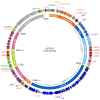Identification and Characterisation of pST1023 A Mosaic, Multidrug-Resistant and Mobilisable IncR Plasmid
- PMID: 36014010
- PMCID: PMC9412624
- DOI: 10.3390/microorganisms10081592
Identification and Characterisation of pST1023 A Mosaic, Multidrug-Resistant and Mobilisable IncR Plasmid
Abstract
We report the identification and characterisation of a mosaic, multidrug-resistant and mobilisable IncR plasmid (pST1023) detected in Salmonella ST1023, a monophasic variant 4,[5],12:i: strain of widespread pandemic lineage, reported as a Southern European clone. pST1023 contains exogenous DNA regions, principally gained from pSLT-derivatives and IncI1 plasmids. Acquisition from IncI1 included oriT and nikAB and these conferred the ability to be mobilisable in the presence of a helper plasmid, as we demonstrated with the conjugative plasmids pST1007-1D (IncFII) or pVC1035 (IncC). A sul3-associated class 1 integron, conferring resistance to aminoglycosides, chloramphenicol and trimethoprim-sulphonamides, was also embedded in the acquired IncI1 DNA segment. pST1023 also harboured an additional site-specific recombination system (rfsF/rsdB) and IS elements of the IS1, IS5 (IS903 group) and IS6 families. Four of the six IS26 elements present constituted two pseudo-compound-transposons, named PCT-sil and PCT-Tn10 (identified here for the first time). The study further highlighted the mosaic genetic architecture and the clinical importance of IncR plasmids. Moreover, it provides the first experimental data on the ability of IncR plasmids to be mobilised and their potential role in the horizontal spread of antimicrobial-resistant genes.
Keywords: IS26; IncR plasmid; Salmonella Southern European clone; antimicrobial resistance; mobilisable; mosaic; pseudo-compound transposons; sul3-associated class 1 integron.
Conflict of interest statement
The authors declare no conflict of interest.
Figures


References
LinkOut - more resources
Full Text Sources

